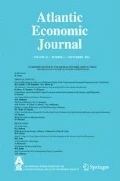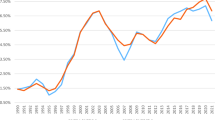Abstract
A number of researchers have claimed that the international monetary and financial system faces a Triffin dilemma in a new fiscal form. In particular, there is said to be a dilemma between satisfying the world’s demand for safe assets and maintaining the solvency of the issuer of such safe assets. On one horn of the dilemma, global deflation threatens if highly creditworthy sovereigns like the U.S. Treasury do not satisfy emerging market demand. On the other horn, a loss of creditworthiness of the issuer threatens as its government debt to gross domestic product (GDP) ratio rises to satisfy fast-growing global demand. This article suggests that the analogy drawn with the original Triffin dilemma is not tight since the safe asset dilemma does not have a clear cross-over point into instability. This paper casts empirical doubt on the claim that such a dilemma exists. On the demand side, emerging market central banks have actually turned to selling safe assets in the last several years, as against forecasts for an ongoing precautionary accumulation. U.S. Treasury yields have actually risen above those on generic private instruments, the opposite of the predicted widening spread of risky over safe yields. On the supply side, a substantial fraction of U.S. dollar reserve assets is invested in instruments other than U.S. Treasury securities. Reserve managers find safe assets among obligations issued by supranationals, national agencies and even large banks, which enjoy varying degrees of governmental support. Thus, demand for safe assets looks less secular than cyclical and the supply of safe dollar assets does not depend solely on U.S. fiscal deficits.





Similar content being viewed by others
Notes
See Carlson et al. (2016) for work on safe assets in the U.S. economy.
Recent observations of negative government bond yields make the safety trap less likely.
Leeper and Walker (2011) describe the fiscal theory of the price level which foresees the inflation outcome.
For an earlier dissent, see Portes (2012).
The valuation effect of the stronger dollar on non-dollar holding in reserves implies that the decline in the stock overstates substantially the drawdown of reserves. See IMF (2017a) for an estimated decomposition.
References
Bloomberg. (2017). www.bloomberg.com, pages USGG10YR Index; GTDEM10Y Govt; USSA10 Curncy; EUSA10 Curncy.
Bordo, M. D. (1993). The Bretton Woods International Monetary System: A historical overview. In M. Bordo & B. Eichengreen (Eds.), A retrospective on the Bretton Woods System (pp. 3–108). Chicago: University of Chicago Press for the NBER.
Caballero, R. J., & Farhi, E. (2013). “A model of the safe asset mechanism (SAM): safety traps and economic policy”. NBER Working Paper 18737 http://www.nber.org/papers/w18737.pdf.
Caballero, R. J., Farhi, E., & Gourinchas, P.-O. (2016). Safe asset scarcity and aggregate demand. American Economic Review: Papers & Proceedings 2016, 106(5), 513–518.
Carlson, M., Duygan-Bump, B., Natalucci, F., Nelson W., Ochoa, M., Stein J., & van den Heuvle, S. (2016). “The demand for short-term, safe assets and financial stability”. International Journal of Central Banking, vol 12, no 4, December, 307-333.
Clark, J., & Mann, G. (2016). “Examining swap spreads and the implications for funding the government”. Treasury Notes, 9 June https://www.treasury.gov/connect/blog/Pages/Examining-Swap-Spreads-and-the-Implications-for-Funding-the-Government.aspx.
Farhi, E., Gourinchas, P.-O., & Rey, H. (2011). Reforming the International Monetary System. London: Centre for Economic Policy Research.
IMF. (2012). “Safe assets: financial system cornerstone?”. Global Financial Stability Report, April http://www.imf.org/external/pubs/ft/gfsr/2012/01/ .
IMF. (2017a). Global Financial Stability Report, April https://www.imf.org/en/Publications/GFSR/Issues/2017/03/30/global-financial-stability-report-april-2017.
IMF. (2017b). Currency composition of official foreign exchange reserves (COFER). http://data.imf.org/?sk=E6A5F467-C14B-4AA8-9F6D-5A09EC4E62A4 .
Jeanne, O. (2012). The dollar and its discontents. Journal of International Money and Finance, 31, 1976–1989.
Leeper, E., & Walker, T. (2011). “Perceptions and misperceptions of fiscal inflation”. BIS Working Papers, no 364, November http://www.bis.org/publ/work364.pdf.
Ma, G., & McCauley, R. (2014). Global and European imbalances: China and Germany. China and World Economy, 22(1), 1–29.
Maggiori, M., & Farhi, E. (2017). “A model of the international monetary system”. Quarterly Journal of Economics, qjx031.https://doi.org/10.1093/qje/qjx031.
McCauley, R., & Rigaudy, J.-F. (2011). “Managing foreign exchange reserves in the crisis and after”. In Portfolio and risk management for central banks and sovereign wealth funds, BIS Papers no 58, October, 19–47. http://www.bis.org/publ/bppdf/bispap58b.pdf
Obstfeld, M. (2011). “International liquidity: the fiscal dimension”. NBER Working Paper 17379 http://www.nber.org/papers/w17379.pdf.
Portes, R. (2012). A reassessment of the Triffin Dilemma. In J.-C. Koeune & A. Lamfalussy (Eds.), In search of a new world monetary order, Proceedings of a conference to celebrate the 100th anniversary of Robert Triffin (1911–1993) (pp. 195–199). Brussels: P I E Peter Lang for the Fondation Internationale Triffin.
Summers, L. (2016). Mundell-Fleming Lecture, 3 November http://www.imf.org/external/np/res/seminars/2016/arc/pdf/Summers_Mundell-Fleming.pdf; http://www.imf.org/external/mmedia/view.aspx?vid=5196724125001.
Swoboda, A. (1968). “The euro-dollar market: an interpretation”. Princeton Essays in International Finance, no 64. https://www.princeton.edu/~ies/IES_Essays/E64.pdf
Triffin, R. (1960). Gold and the dollar crisis: the future of convertibility. New Haven, CT: Yale University Press.
U. S. Department of Commerce, Bureau of Economic Analysis (2017). Table 3.1. U.S. International Investment Position for Liabilities to Foreign Official Agencies at the End of the Period. https://www.bea.gov/iTable/iTable.cfm?reqid=62&step=1#reqid=62&step=6&isuri=1&6210=5&6200=150.
U.S Department of Treasury. (2017a). Monthly Statement of the Public Debt. https://www.treasurydirect.gov/govt/reports/pd/mspd/mspd.htm.
U.S. Department of Treasury. (2017b). Treasury International Capital data, Transactions with Foreign-Residents in Long-Term Securities, https://www.treasury.gov/resource-center/data-chart-center/tic/Pages/ticsec.aspx.
Acknowledgements
The authors thank José Maria Vidal Pastor for research assistance. The views expressed are those of the authors and not necessarily those of Rutgers University or the Bank for International Settlements.
Author information
Authors and Affiliations
Corresponding author
Rights and permissions
About this article
Cite this article
Bordo, M., McCauley, R.N. A Global Shortage of Safe Assets: A New Triffin Dilemma?. Atl Econ J 45, 443–451 (2017). https://doi.org/10.1007/s11293-017-9558-2
Published:
Issue Date:
DOI: https://doi.org/10.1007/s11293-017-9558-2




